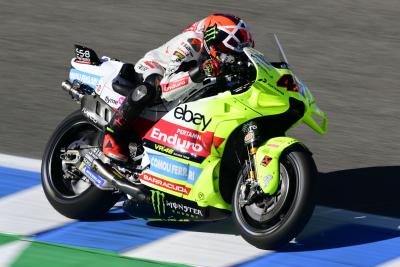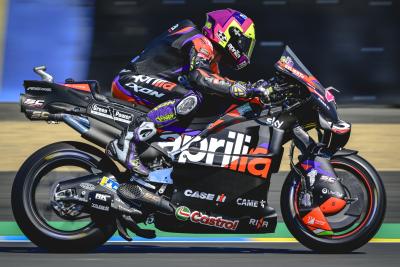Aero, devices make MotoGP ‘like Formula 1 on two wheels’
“As soon as the engineers understand more the new regulations, they will find some way to have crazy things on the bike again”
While many MotoGP riders greeted the removal of ride-height devices and trimming of aerodynamics in the 2027 technical rules with approval, Fabio di Giannantonio admitted he ‘loves’ the ‘F1’ technology on the current machines.
However, the 2023 Qatar Grand Prix winner does hope that overtaking will become easier with a return to more ‘normal’ bikes.
“It will be different, for sure,” di Giannantonio said of the 2027 regulations, which include a headline reduction in engine size to 850cc.
“The new engines will be different, also the new aero.
“Everything will be much more... ‘normal’ maybe, more like a normal bike.
“I'm loving MotoGP at the moment, because the aero is fantastic, the devices stuff is like Formula 1 on two wheels.”
The Italian, who has switched from Gresini to VR46 this season, added:
“For the future, it will be interesting to see if this regulation [change] makes us ride closer and have closer battles.
"Because at the moment, it's a bit tough to be really really close to the guy in front.”
But di Giannantonio also warned that the engineers will soon learn how to exploit the revised rules.
“At the beginning, everything will be more easy, more calm, but as soon as the engineers understand more the new regulations, I think they will find some way to have crazy things on the bike again,” he said.
KTM’s Brad Binder said the loss of ride-height/holeshot devices will make the most difference during race starts.
“The place I'm going to miss it is the start, for sure. Because the bike is so stable and it's much easier to launch,” said the South African. “All we'll do [without them] is drop the power, so it's going to be a bit slower.”
Aleix Espargaro said Aprilia engineers estimate the 150cc reduction in engine capacity, plus smaller maximum bore, will result in “around 35hp less” output and a ‘significant’ increase in lap times.
“We are racing in the same circuits, more or less, that Doohan and Criville were racing on with the 500s and [now] Moto3 are doing the same lap times,” Espargaro said, referring to the eye-opening stat that David Alonso’s 1m 43.710s Moto3 lap during this year’s Jerez event was faster than Mick Doohan set on his way to 500cc victory in the 1996 Spanish Grand Prix.
“It means that the circuits are not prepared any more,” Espargaro added. “[The circuits] can be modified a little bit but the space is what it is. So we need to reduce a bit the performance.
“The engineers are too intelligent and there is too much technology and we need to block this a little bit. For the show also it will be better… The people at home don’t really care if we lap 1.5 seconds [slower]. The bikes will still perform super-good as well, but the show will be much better.
“I love these bikes with the aerodynamics. To ride them is unbelievable. The amount of speed you can carry is crazy,” Espargaro said. “But in terms of the show, it is hard to overtake the riders in front of you.”
The Spaniard also emphasised that WorldSBK will now need a similar performance drop from its future rules.
“Obviously, you cannot change the [MotoGP] rules like this and keep giving qualifying tyres to Superbikes otherwise the streetbikes will be faster than the MotoGPs and people at home will not understand,” he said.
“But if you reduce the level of all categories it will be better for the safety and for the show - everybody’s happy.”
The FIM has confirmed that talks are ongoing with the WorldSBK manufacturers for a similar reduction in performance to avoid overlapping with MotoGP.




![Johann Zarco, LCR, Honda RC213V, 2024 San Marino MotoGP, Misano, action [Gold & Goose]](https://cdn.crash.net/styles/thumbnail/s3/2024-09/GnG_1166323_HiRes.jpg?itok=vpgrU7Q4)

![Jack Miller, KTM Factory Racing, KTM RC16, San Marino MotoGP, Misano, action [Gold & Goose]](https://cdn.crash.net/styles/thumbnail/s3/2024-09/GnG_1167624_HiRes.jpg?itok=iz7mA4EQ)


![Fabio Quartararo, Monster Energy Yamaha Racing, Yamaha M1, 2024 MotoGP, Misano Test, action [Gold & Goose]](https://cdn.crash.net/styles/thumbnail/s3/2024-09/GnG_1168928_HiRes.jpg?itok=fcYSole_)
![Toprak Razgatlioglu, ROKiT BMW Motorrad, BMW M 1000 RR, Magny-Cours, WorldSBK [Gold & Goose]](https://cdn.crash.net/styles/thumbnail/s3/2024-09/GnG_1165133_HiRes.jpg?itok=GD5SVNVG)

